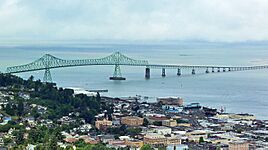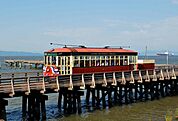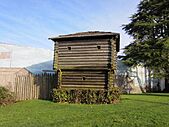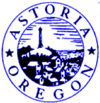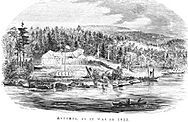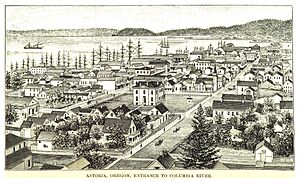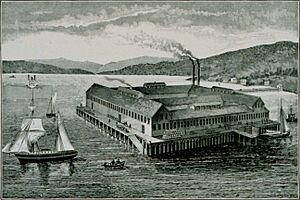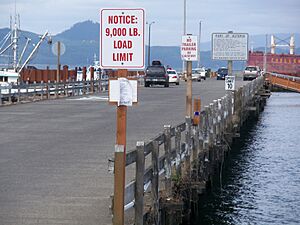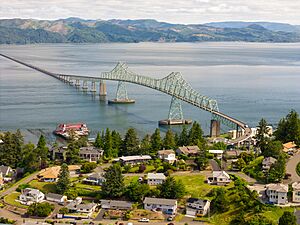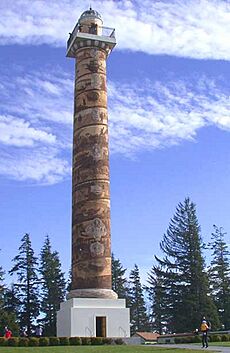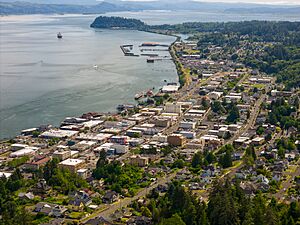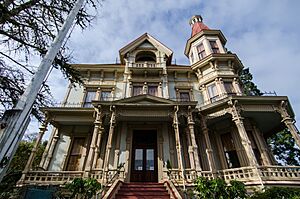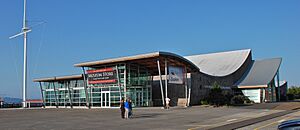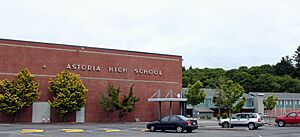Astoria, Oregon facts for kids
Quick facts for kids
Astoria
|
||
|---|---|---|
|
|
||
|
||
| Country | United States | |
| State | Oregon | |
| County | Clatsop | |
| Founded | 1811 | |
| Incorporated | 1876 | |
| Named for | John Jacob Astor | |
| Area | ||
| • Total | 9.95 sq mi (25.77 km2) | |
| • Land | 6.11 sq mi (15.82 km2) | |
| • Water | 3.84 sq mi (9.95 km2) | |
| Elevation | 118 ft (36 m) | |
| Population
(2020)
|
||
| • Total | 10,181 | |
| • Density | 1,666.56/sq mi (643.42/km2) | |
| Time zone | UTC−08:00 (PST) | |
| • Summer (DST) | UTC−07:00 (PDT) | |
| ZIP Code |
97103
|
|
| Area codes | 503 and 971 | |
| FIPS code | 41-03150 | |
| GNIS feature ID | 2409744 | |
Astoria is a port city in Oregon, United States. It's the main city in Clatsop County, Oregon. Founded in 1811, Astoria is the oldest city in Oregon. It was also the first lasting American settlement west of the Rocky Mountains.
Astoria is located on the south shore of the Columbia River. This is where the river flows into the Pacific Ocean. The city is named after John Jacob Astor, a rich businessman from New York City. His company, the American Fur Company, built Fort Astoria here. This fort helped them control the fur trade in the early 1800s. Astoria officially became a city on October 20, 1856.
The city has a deepwater Port of Astoria for ships. You can also travel by air from the Astoria Regional Airport. Main highways like U.S. Route 30 and U.S. Route 101 pass through Astoria. The Astoria–Megler Bridge, which is about 4.1 miles long, connects Astoria to Washington across the river. In 2020, about 10,181 people lived in Astoria.
Contents
History of Astoria
Early Settlements
Long ago, the area where Astoria is now was part of a big trading network. This network was used by Native American tribes from the Columbia Plateau.
19th Century Events
The famous Lewis and Clark Expedition spent the winter of 1805–1806 near modern-day Astoria. They stayed at Fort Clatsop, a small log fort. They hoped a ship would take them back east, but they had to travel back overland. Today, a replica of Fort Clatsop is part of the Lewis and Clark National Historical Park.
In 1811, British explorer David Thompson reached the mouth of the Columbia River. He found Fort Astoria already being built. It was started by the Pacific Fur Company's ship, the Tonquin. This fort helped the United States claim the area, not Britain. It was important for American exploration of the continent.
The Pacific Fur Company was part of John Jacob Astor's American Fur Company. It was set up to trade furs in the Oregon Country. During the War of 1812 in 1813, the company sold its property to a Canadian rival. They renamed the fort Fort George. The fur trade stayed under British control for a while. But in the mid-1840s, American pioneers started arriving on the Oregon Trail. The Treaty of 1818 allowed both the U.S. and Britain to use the Oregon Country.
A famous American writer, Washington Irving, wrote a book called Astoria in 1835. He wrote it while staying with John Jacob Astor. The book made the region seem very important to Americans. Irving called the fur traders "Sinbads of the wilderness." He saw their business as a way for America to grow its economy.
In 1846, the Oregon Treaty officially made Astoria part of the United States. As more Americans moved to the Oregon Territory, Astoria grew as a port city. It was located at the mouth of the Columbia River, which was an easy way to get inland. The first U.S. post office west of the Rocky Mountains opened in Astoria in 1847. The city was officially incorporated in 1876.
Many immigrants came to Astoria in the late 1800s. These included people from Nordic countries (like Sweden and Finland) and Chinese people. Nordic settlers often worked in fishing. Chinese immigrants usually worked in canneries. By the late 1800s, 22% of Astoria's population was Chinese. There were also many Indians, especially Sikhs from Punjab. A political group called the Ghadar Party was started in Astoria in 1913.
20th and 21st Centuries
In 1883 and again in 1922, downtown Astoria was destroyed by big fires. This happened because many buildings were made of wood and built on wooden stilts over marshy ground. Even after the first fire, they rebuilt in the same way. In the second fire, the flames spread quickly. The collapsing streets even broke the water system. People used dynamite to blow up buildings to stop the fire from spreading.
| Panoramic views of Astoria in the early 20th century |
|---|
Astoria has been a port for over 100 years. It is still a trading center for the lower Columbia River area. In the early 1900s, the Callendar Navigation Company was an important shipping business there. However, cities like Portland, Oregon and Seattle, Washington became bigger economic centers. Astoria's economy used to rely on fishing, fish processing, and cutting lumber. In 1945, there were about 30 canneries along the Columbia River.
Over time, the number of Pacific salmon decreased, and canneries closed. In 1974, the Bumble Bee Seafoods company moved its main office from Astoria. It closed its last cannery in Astoria in 1980. The lumber industry also declined in the late 1900s. Astoria Plywood Mill, which was the city's biggest employer, closed in 1989. The Burlington Northern and Santa Fe Railway stopped train service to Astoria in 1996.
From 1921 to 1966, a ferry boat connected Astoria with Pacific County, Washington across the Columbia River. In 1966, the Astoria–Megler Bridge opened. This bridge completed U.S. Route 101 and replaced the ferry service.
Today, Astoria's economy mainly relies on tourism, its growing art scene, and light manufacturing. Logging and fishing still happen, but much less than before. Since 1982, Astoria has been a stop for cruise ships. The city and port spent $10 million to improve the piers for these large ships.
Besides the replica of Fort Clatsop, another interesting place is the Astoria Column. This tower is 125 feet high and sits on top of Coxcomb Hill. You can climb its spiral staircase to see amazing views of the town, the land around it, and the Columbia River flowing into the Pacific Ocean. The tower was built in 1926. It was funded by the Great Northern Railway to attract tourists, and by Vincent Astor, a great-grandson of John Jacob Astor.
Since 1998, artists who are also fishermen from Alaska and the Pacific Northwest come to Astoria for the Fisher Poets Gathering. Here, poets and singers share stories and songs about fishing life.
Another popular yearly event is the Dark Arts Festival. It features music, art, dance, and demonstrations like blacksmithing. It also offers many dark craft beers. The festival started small but now takes place at Fort George Brewery. It attracts hundreds of visitors, even tour buses from Seattle.
Astoria is the end point of the TransAmerica Bicycle Trail. This is a 4,250-mile bicycle route that goes across the country.
Three United States Coast Guard ships are based in Astoria: the Steadfast, Alert, and Elm.
Astoria's Geography
Astoria covers about 10.11 square miles. About 3.95 square miles of this is water.
Climate in Astoria
Astoria has a Mediterranean climate. This means it has cool winters and mild summers. Sometimes, there can be short heat waves. It rains most in late fall and winter. July and August are the driest months. On average, Astoria gets about 67 inches of rain each year. Snowfall is rare, usually less than 5 inches a year.
Astoria's air is usually humid, meaning it has a lot of moisture. The average humidity is always over 80% throughout the year. It's highest from November to March (84%) and lowest in May (81%).
On average, only about 4 afternoons a year reach temperatures of 80°F or higher. Temperatures of 90°F are very rare. Usually, only one or two nights a year stay at or above 60°F. About 31 mornings a year have temperatures at or below freezing. The highest temperature ever recorded was 101°F on July 1, 1942, and June 27, 2021. The lowest temperature ever was 6°F on December 8, 1972, and December 21, 1990. Even with cold record lows, winter afternoons are usually mild.
| Climate data for Astoria Regional Airport (1991–2020 normals, extremes 1892–present) | |||||||||||||
|---|---|---|---|---|---|---|---|---|---|---|---|---|---|
| Month | Jan | Feb | Mar | Apr | May | Jun | Jul | Aug | Sep | Oct | Nov | Dec | Year |
| Record high °F (°C) | 70 (21) |
72 (22) |
80 (27) |
85 (29) |
93 (34) |
101 (38) |
101 (38) |
98 (37) |
95 (35) |
85 (29) |
73 (23) |
64 (18) |
101 (38) |
| Mean maximum °F (°C) | 58.9 (14.9) |
61.4 (16.3) |
65.5 (18.6) |
71.9 (22.2) |
77.8 (25.4) |
79.1 (26.2) |
81.7 (27.6) |
83.7 (28.7) |
81.9 (27.7) |
74.1 (23.4) |
62.8 (17.1) |
57.9 (14.4) |
89.4 (31.9) |
| Mean daily maximum °F (°C) | 49.4 (9.7) |
50.9 (10.5) |
53.0 (11.7) |
55.9 (13.3) |
60.5 (15.8) |
64.0 (17.8) |
67.4 (19.7) |
68.7 (20.4) |
67.6 (19.8) |
60.7 (15.9) |
53.6 (12.0) |
48.7 (9.3) |
58.4 (14.7) |
| Daily mean °F (°C) | 43.7 (6.5) |
44.2 (6.8) |
46.0 (7.8) |
48.7 (9.3) |
53.4 (11.9) |
57.3 (14.1) |
60.6 (15.9) |
61.3 (16.3) |
59.0 (15.0) |
52.8 (11.6) |
46.9 (8.3) |
43.2 (6.2) |
51.4 (10.8) |
| Mean daily minimum °F (°C) | 38.1 (3.4) |
37.4 (3.0) |
39.0 (3.9) |
41.5 (5.3) |
46.3 (7.9) |
50.6 (10.3) |
53.9 (12.2) |
53.9 (12.2) |
50.5 (10.3) |
44.9 (7.2) |
40.2 (4.6) |
37.6 (3.1) |
44.5 (6.9) |
| Mean minimum °F (°C) | 27.2 (−2.7) |
26.7 (−2.9) |
29.6 (−1.3) |
33.3 (0.7) |
37.6 (3.1) |
43.0 (6.1) |
46.9 (8.3) |
46.7 (8.2) |
41.8 (5.4) |
34.1 (1.2) |
29.3 (−1.5) |
26.8 (−2.9) |
22.6 (−5.2) |
| Record low °F (°C) | 11 (−12) |
9 (−13) |
22 (−6) |
26 (−3) |
30 (−1) |
37 (3) |
37 (3) |
39 (4) |
33 (1) |
26 (−3) |
15 (−9) |
6 (−14) |
6 (−14) |
| Average precipitation inches (mm) | 10.59 (269) |
7.18 (182) |
7.90 (201) |
5.80 (147) |
3.40 (86) |
2.30 (58) |
0.83 (21) |
1.12 (28) |
2.67 (68) |
6.74 (171) |
11.05 (281) |
10.68 (271) |
70.26 (1,785) |
| Average snowfall inches (cm) | 0.4 (1.0) |
0.5 (1.3) |
0.0 (0.0) |
0.0 (0.0) |
0.0 (0.0) |
0.0 (0.0) |
0.0 (0.0) |
0.0 (0.0) |
0.0 (0.0) |
0.0 (0.0) |
0.3 (0.76) |
0.2 (0.51) |
1.4 (3.6) |
| Average precipitation days (≥ 0.01 in) | 21.6 | 18.8 | 21.5 | 19.2 | 15.5 | 13.7 | 8.1 | 7.7 | 10.1 | 16.6 | 21.1 | 22.0 | 195.9 |
| Average snowy days (≥ 0.1 in) | 0.6 | 0.7 | 0.0 | 0.0 | 0.0 | 0.0 | 0.0 | 0.0 | 0.0 | 0.0 | 0.1 | 0.3 | 1.7 |
| Average relative humidity (%) | 82.7 | 82.2 | 80.9 | 79.5 | 79.5 | 79.8 | 79.8 | 81.6 | 81.1 | 82.9 | 83.3 | 84.0 | 81.4 |
| Average dew point °F (°C) | 36.7 (2.6) |
38.7 (3.7) |
39.4 (4.1) |
41.4 (5.2) |
45.9 (7.7) |
50.2 (10.1) |
53.1 (11.7) |
54.1 (12.3) |
51.8 (11.0) |
47.1 (8.4) |
41.9 (5.5) |
37.8 (3.2) |
44.8 (7.1) |
| Source: NOAA (relative humidity and dew point 1961–1990, snowfall & snow days 1981–2010) | |||||||||||||
Astoria's Population
| Historical population | |||
|---|---|---|---|
| Census | Pop. | %± | |
| 1860 | 252 | — | |
| 1870 | 639 | 153.6% | |
| 1880 | 2,803 | 338.7% | |
| 1890 | 6,184 | 120.6% | |
| 1900 | 8,351 | 35.0% | |
| 1910 | 9,599 | 14.9% | |
| 1920 | 14,027 | 46.1% | |
| 1930 | 10,349 | −26.2% | |
| 1940 | 10,389 | 0.4% | |
| 1950 | 12,331 | 18.7% | |
| 1960 | 11,239 | −8.9% | |
| 1970 | 10,244 | −8.9% | |
| 1980 | 9,998 | −2.4% | |
| 1990 | 10,069 | 0.7% | |
| 2000 | 9,813 | −2.5% | |
| 2010 | 9,477 | −3.4% | |
| 2020 | 10,181 | 7.4% | |
| Sources: | |||
In 2010, Astoria had 9,477 people living in 4,288 homes. About 2,274 of these were families. The city's population density was about 1,538 people per square mile. Most residents (89.2%) were White. Other groups included African American (0.6%), Native American (1.1%), Asian (1.8%), and Pacific Islander (0.1%). About 9.8% of the population was Hispanic or Latino.
The average age in Astoria was 41.9 years old. About 20.3% of residents were under 18. About 17.1% were 65 or older.
Arts and Culture in Astoria
Museums and Fun Places to Visit
Astoria has many interesting places to visit:
- The Astoria Riverwalk, where you can ride the Astoria Riverfront Trolley.
- The Columbia River Maritime Museum and the Uppertown Firefighters Museum.
- The Astoria Column, which is the highest point in Astoria.
- The Heritage Museum, located in the Old City Hall.
- Fort Astoria and Fort George Brewery.
- The Astor Building and the Liberty Theater.
- The Museum of Whimsy, Astoria Sunday Market, and Garden of Surging Waves.
- The Oregon Film Museum and the Flavel House.
- Astoria Regional Airport with CGAS Astoria.
- Fort Stevens, Clatsop Spit, Fort Clatsop, and Youngs River Falls.
Shanghaied in Astoria is a musical play about Astoria's history. It has been performed in Astoria every year since 1984.
Education in Astoria
The Astoria School District has four schools for younger students and high school. This includes Astoria High School. Clatsop Community College is the city's two-year college. Astoria also has a public library and many parks. The city is home to the second oldest Job Corps facility in the country, called Tongue Point Job Corps. It's the only one that teaches seamanship (skills for working on ships).
Media and Filming in Astoria
The Astorian is the main newspaper in Astoria. It started in 1873 and has been published ever since. The Coast River Business Journal is a monthly magazine about business in the area. The local NPR station is KMUN 91.9. KAST 1370 is a local news-talk radio station.
Astoria as a Filming Location
Astoria is famous for being the setting of many movies! The 1985 film The Goonies was filmed right here in the city. Other well-known movies filmed in Astoria include:
- Short Circuit
- The Black Stallion
- Kindergarten Cop
- Free Willy and Free Willy 2: The Adventure Home
- Teenage Mutant Ninja Turtles III
- Benji the Hunted
- The Ring Two
- Into the Wild
- The Guardian
- Green Room
Notable People from Astoria
- Bobby Anet, college basketball player who helped the University of Oregon win a championship.
- Jona Bechtolt, a Grammy-nominated electronic musician.
- Brian Bruney, a professional baseball pitcher.
- Honey Lee Cottrell, photographer and activist.
- Marie Dorion, the only female member of an early expedition to Fort Astoria.
- George Flavel, a maritime pilot and businessman.
- Grouper, an ambient musician (Elizabeth Anne Harris).
- Michael Hurley, an American singer/songwriter.
- Duane Jarvis, an American guitarist and singer/songwriter.
- Wally Johansen, a college basketball player for the University of Oregon.
- Consuelo Kanaga, a photographer known for pictures of African-Americans.
- Kenneth Koe, a chemist who helped create the medicine Zoloft.
- Carl W. Leick, an architect who designed famous buildings in Astoria.
- Rosa Lemberg, a Finnish American teacher and socialist.
- Armand Lohikoski, an American-born Finnish movie director.
- Ranald MacDonald, the first person to teach English in Japan.
- Donald Malarkey, a World War II soldier shown in the TV series Band of Brothers.
- Petra Mathers, a writer and illustrator of children's books.
- George H. Merryman, a doctor and politician in Oregon.
- Royal Nebeker, an American painter.
- Gene Nelson, an American dancer, actor, and director.
- Maila Nurmi, also known as Vampira, a TV horror hostess and actress.
- Jordan Poyer, an NFL football player who grew up in Astoria.
- Ken Raymond, an expert in chemistry.
- Wilbur Ternyik, a civic leader and mayor of Florence, Oregon.
- Willis Van Dusen, a businessman and long-time mayor of Astoria.
- Eric Zener, an American artist known for paintings of people swimming.
Sister Cities
Astoria has one sister city:
 Walldorf, Germany. This is the birthplace of John Jacob Astor, who Astoria is named after. The sister city relationship started in 1963.
Walldorf, Germany. This is the birthplace of John Jacob Astor, who Astoria is named after. The sister city relationship started in 1963.
See also
 In Spanish: Astoria (Oregón) para niños
In Spanish: Astoria (Oregón) para niños


